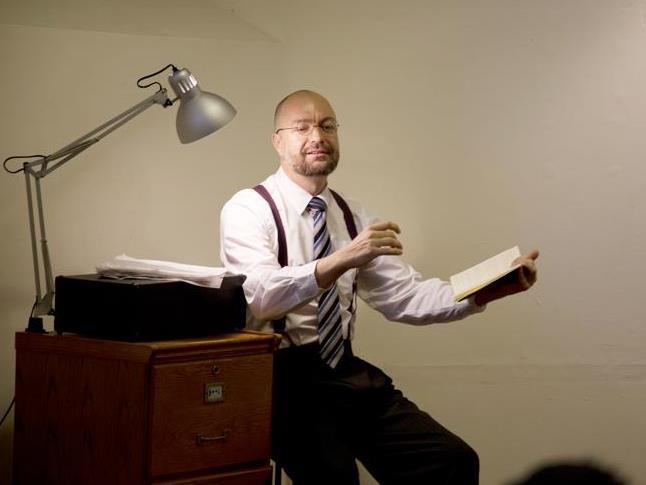James Berlyn in Crash Course. Photo by Fionn Mulholland.
James Berlyn presents a full length immersive class, drawing on classic pedagogical techniques as well as observation and skilful mimicry of teacher personality types.
Having suffered a trauma that has left us unable to remember our own language, as well as disabling our dominant hands (all placed in slings), we are sent into a classroom for a Crash Course. Our teacher, Mr Jakabo, enters with a brisk, if slightly distracted, air. He hands out books, gives directions, writes on the board, and then recites poetry from Blargar Tsinden. He continues to expand on the themes of the poem, the beauty of the language and makes comparisons to the lesser poets that Tsinden is likened to – Blake, Rilke et al. He then gives further instructions, and is taken aback to find that not a single word has been understood. He disappears out the door, looking for the course administrator. Shouting ensues, in which he realises that he has been allocated the crash course class, rather than his standard lesson, extolling the lyrical delights of the Winfein language.
Following his initial shock, he tries to proceed with the revised lesson. He recalls all books and worksheets, but then finds the stress of the situation reducing him to a thumb-sucking wreck. He takes us through the numbers of the base 12 number system, with its own numerals and phonetic lettering. Simple cards are used, and a piano accordion appears to lead us through the counting system. Sample vocabulary appears, with their definitions acted out and drawn on the blackboard.
The letters of the writing system are introduced, with vowels and consonants separated. Here, Jakabo/Berlyn takes us through a delightful demonstration of form, sound and dedication to teaching, as he uses his body to take us through the formation of each letter and then spelling out his name, all to the strains of his portable gramophone. The lesson concludes strongly, with students learning to write their own names and having the full meaning of the term “Crash Course” explained in various ways, and Jakabo escaping the room smartly, exuding relief.
As with any properly immersive performance, each person’s experience will differ. With a background in language study and instruction, I found the entire experience fascinating and admired the lesson structure and traditional techniques used for teaching and learning. My monolingual, hearing-impaired plus one found some sections dreary but was entertained by the actor’s silliness in his breakdowns and explanatory role plays. I’m sure that the other desks would have offered up further, differing opinions. I liked the script developed for Winfein, it had sound linguistic points and Berlyn did the full body spell out admirably.
Berlyn held us all both by his teaching capabilities and his dramatic flair – his character was consistently believable and compelling. His use of the limited available theatrical resources in the classroom setting was further character reinforcement, but his detailed pantomimes were a pure joy in themselves. The selection of musical accompaniments on the gramophone lent a cinematic air to proceedings, whether that was from the “plucky teacher” genre or “war tragedy” was debatable.
A risk-taking production in the immersive theatre tradition, with skill, verve and good-humour, Berlyn makes it work for all participants.
4 Stars
Crash Course
Presented by James Berlyn in association with PICA
Created by James Berlyn
Directed by Nikki Heywood
Produced by Performing Lines WA
Lighting Designer: Jenny Vila
Sound Designer: Geoff Baker
Graphic Design: Shaun Salmon
Costume Design: Anne Marie Terese
Performed by James Berlyn and Sarah Nelson
Perth Institute of Contemporary Art, Perth Cultural Centre, Northbridge





